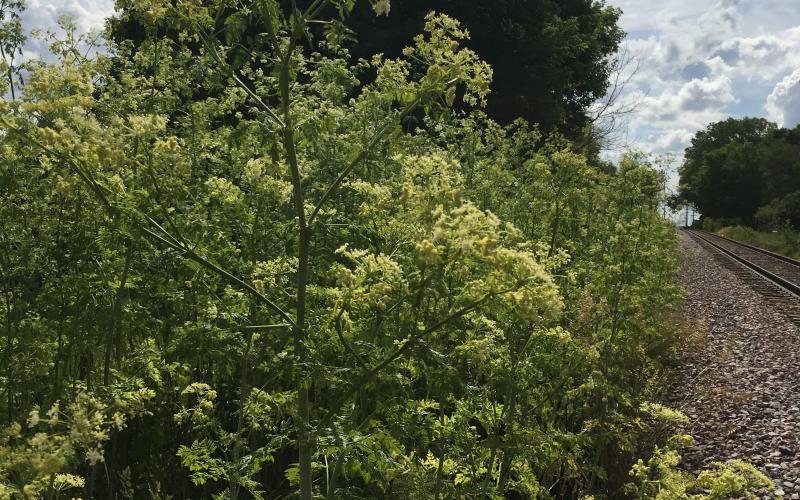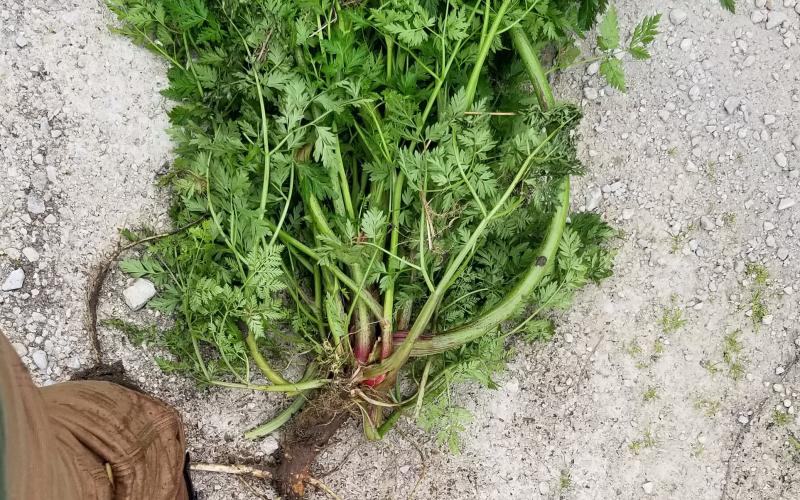Common name: Poison Hemlock
Scientific name: Conium maculatum L.
Legal Status
Efforts must be made to prevent seed maturation and dispersal of plants into new areas. Additionally, no transportation, propagation, or sale of these plants is allowed. Failure to comply may result in enforcement action by the county or local municipality.
Background
Poison hemlock is native to Europe and was brought to North America as an ornamental plant. It is a member of the carrot family (Apiaceae) and it may be mistaken for similar white flowered carrot family plants such as wild carrot.
Description
- Poison hemlock is a biennial herbaceous plant. It is a low-growing rosette in its first year and matures the second year by developing a tall flowering stalk that grows up to 8 feet.
- The stems are hollow, hairless, and have ridges and purple spots or mottles.
- Leaves are pinnately compound and fernlike. Leaf petioles clasp to the stem at the node.
- Small white flowers are clustered in umbels 3-6 inches in diameter at the tips of the branches. Plants bloom May-August.
- The plant produces abundant seeds that are flat with ridges.
Water hemlock (Cicuta maculata) is a similar native species that is also very toxic. The flowers are very similar but the leaves of water hemlock are not as fern-like as poison hemlock’s leaves and the stems of water hemlock are not spotted with purple.
Habitat
Poison hemlock is found on roadsides, in pastures, along streambanks, and in ditches.
Means of spread and distribution
Poison hemlock produces abundant seed that can be easily spread by mowing or other equipment.
Impact
**Highly poisonous** to humans and livestock – do not ingest any part of the plant. Use gloves, long sleeves, long pants, and closed-toe boots if working in an infestation. Poison hemlock can grow in dense patches and displaces native vegetation.
Prevention and management
Effective management must prevent seed production and exhaust the seedbank.
- Mow before seed set to prevent movement of seed to new locations. Clean equipment, clothing, and shoes after moving through an infestation.
- Herbicide applications that target rosettes in the early spring and fall can be very effective. Spring treatments of rosettes should be timed well in advance of flowering and follow-up treatments may be necessary for several years to exhaust the seedbank. If using herbicide treatments, check with your local University of Minnesota Extension Agent, co-op, or certified landscape care expert for assistance and recommendations. There are several businesses throughout the state with certified herbicide applicators that can be hired to perform chemical applications.
Toxicity
Poison hemlock is very toxic to humans and livestock. Symptoms of toxicity include: nervous trembling, salivation, pupil dilation, rapid, weak pulse, and eventually leading to coma or death. If you suspect toxicity from poison hemlock, call Minnesota Poison Control System immediately at 1-800-222-1222. For suspected toxicity to animals, call your local veterinarian.



